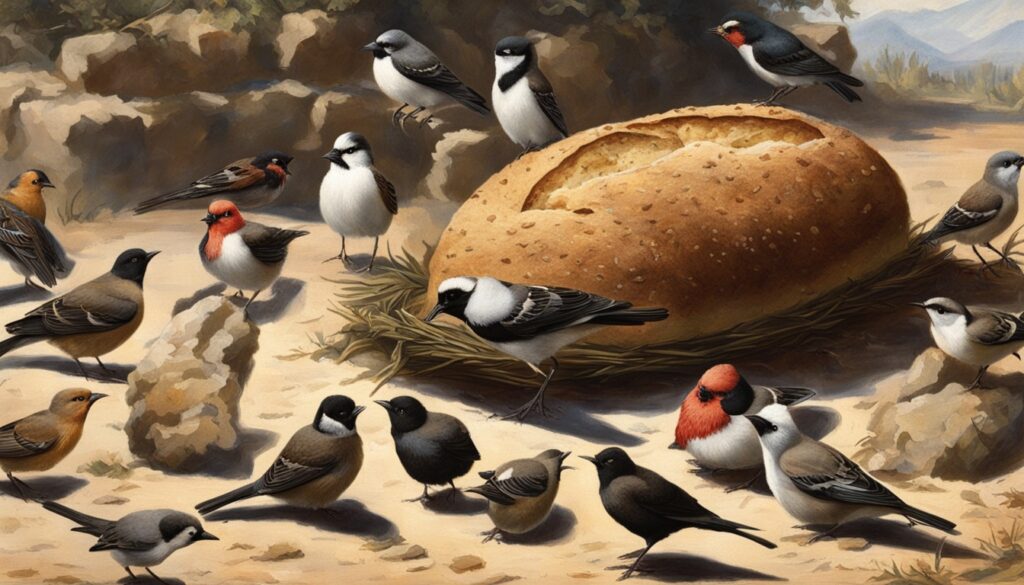Did you know that feeding bread to birds is often worse than not feeding them at all? It’s a startling statistic, but one that highlights the critical importance of understanding the dietary needs of our feathered friends. Bread, a common household staple, may seem like a convenient way to supplement the diets of birds visiting our backyards, but the reality is that it provides little to no nutritional value and can even be detrimental to their health.
Bread, especially the processed white variety, is essentially empty calories for birds. While it may provide some carbohydrates for energy, it lacks the essential nutrients, vitamins, and minerals that birds require to thrive. Feeding birds bread essentially robs them of the opportunity to consume the high-quality, nutrient-dense foods their bodies need to survive and thrive.
Key Takeaways
- Bread has zero nutritional value for wild birds and can be worse than feeding them nothing.
- Bread fills up a bird’s small stomach, leaving them feeling full but without the necessary calories and nutrients.
- Feeding ducks and geese bread, crackers, and other snack foods can lead to health issues like Angel Wing syndrome.
- Whole grain or seeded bread options are better, but should still be offered only occasionally as a treat.
- Providing high-quality, nutrient-dense bird food is essential for supporting the health and well-being of local bird populations.
Introduction: The Perils of Feeding Bread to Birds
While the gesture of feeding bread to wild birds may seem harmless, it can actually be quite detrimental to their health and well-being. Bread, a staple food for many humans, lacks the essential nutrients that birds require for proper nourishment. Feeding bread to birds can have severe consequences, leading to malnutrition, increased susceptibility to predators, and even death.
The avian digestive system is not designed to process the high carbohydrate and low nutrient content of bread. When birds fill up on bread, they are essentially consuming “empty calories” that provide little to no real sustenance. This can cause them to feel full without receiving the vital vitamins, minerals, and proteins they need to thrive.
“Feeding bread to birds is like us eating nothing but cake and cookies – it might taste good, but it’s not actually nourishing our bodies.”
The consequences of improper bird feeding can be far-reaching. Birds that are malnourished due to a bread-heavy diet may have weakened immune systems, making them more susceptible to disease and predation. They may also struggle to maintain their natural foraging and migratory behaviors, putting them at risk of starvation or inability to find suitable habitats.
It’s crucial for the public to understand the dangers of feeding bread to birds and explore healthier alternatives that support their nutritional needs. By educating ourselves and our communities, we can ensure that our avian friends receive the proper care and sustenance they require to thrive.
The Nutritional Deficiencies of Bread for Birds
While the convenience of feeding bread to birds may seem tempting, it is crucial to understand the significant nutritional deficiencies that this common household item poses for our feathered friends. Bread, whether it’s white or whole wheat, simply does not provide the essential nutrients that birds require for optimal health and survival.
Lack of Essential Nutrients
Birds have unique dietary needs that are vastly different from our own. They require a delicate balance of proteins, fats, vitamins, and minerals to support their active lifestyles and rapid metabolism. Unfortunately, bread is severely lacking in these essential nutrients. Instead, it is primarily composed of carbohydrates, which can fill up a bird’s small stomach without providing any meaningful nourishment.
Filling Up on Empty Calories
When birds consume bread, they may feel satisfied for the moment, but they are essentially filling up on empty calories. This can lead to malnutrition, as the birds’ bodies are unable to obtain the necessary sustenance from the bread alone. Over time, this can result in a range of health issues, from weakened immune systems to developmental problems, particularly in young birds.
The scientific evidence is clear: bread is not an appropriate food for birds. While it may be tempting to offer this readily available snack, it is essential to choose more nutritious options that cater to the specific dietary requirements of our feathered friends.
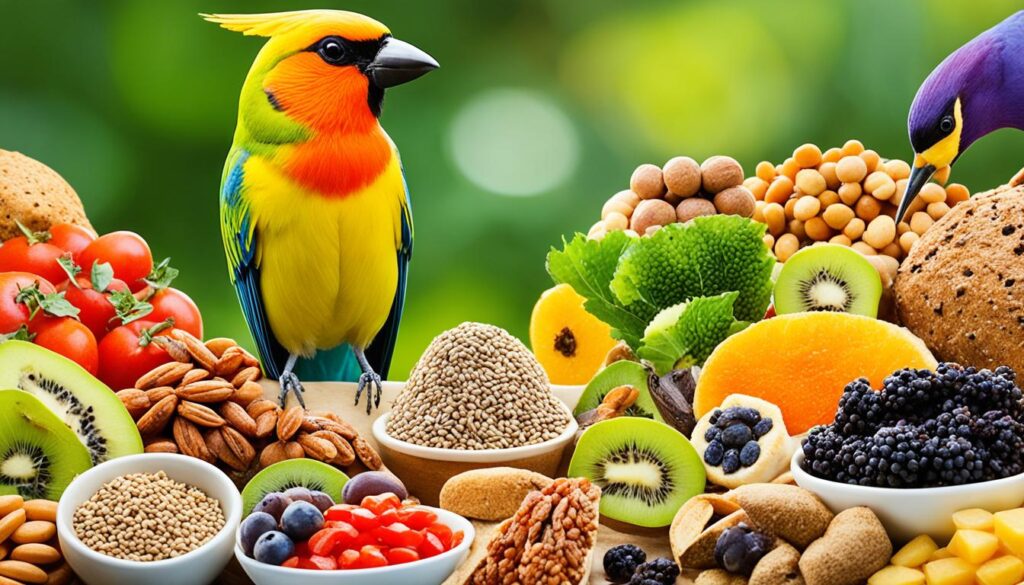
Feeding bread to birds may seem like a harmless gesture, but it can have significant consequences for their health and well-being. The lack of essential nutrients and the abundance of empty calories in bread can lead to a range of problems, from malnutrition to developmental issues.
The Consequences of Improper Bird Feeding
Feeding bread to birds can have severe consequences for their well-being. When birds fill up on the empty calories of bread, they may lack the energy and resources to effectively thermoregulate, evade predators, and carry out essential behaviors. This can result in hypothermia, increased vulnerability to predation, and other life-threatening issues.
Moreover, the nutritional deficiencies caused by a diet heavy in bread can lead to a range of health problems that can undermine the overall health and survival of the birds. Bread offers zero nutrition for wild birds, and in some cases, can be worse than feeding them nothing at all.
“Bread and other human snack foods have zero nutrition for wild birds. Feeding birds bread can be worse than feeding them absolutely nothing.”
Birds need a balanced diet rich in high-density proteins, fats, and carbohydrates to survive and thrive. Bread, however, fills up their stomachs quickly but offers no nourishment, resulting in a deadly combination of factors.
The consequences of improper bird feeding can extend beyond individual birds. Feeding ducks and geese bread, crackers, or snack foods in parks can also lead to health issues, such as Angel Wing syndrome, a condition that causes the last joint of a bird’s wing to twist, rendering them unable to fly.
Proper bird feeding practices are essential to maintaining the health and well-being of local bird populations. By providing fresh, high-quality food in backyard feeders and supporting insect and fruit-eating birds through habitat preservation, we can positively impact the future generations of these feathered friends.
The Dangers of Moldy Bread for Birds
While the nutritional deficiencies of bread can be problematic for birds, the presence of toxic mold on moldy bread poses an even greater threat to their health. Certain types of mold that can grow on bread, such as Stachybotrys chartarum (black mold), Penicillium mold, and Aspergillus mold, are particularly dangerous and can have severe consequences for birds if consumed.
Toxic Mold and Its Effects
Exposure to these toxic molds can lead to a range of adverse effects on birds, including respiratory distress, neurological problems, and organ damage. The mycotoxins produced by the mold can cause vomiting, diarrhea, weakness, immune system suppression, and even death in birds. Consuming moldy bread can also present immediate physical risks, such as digestive issues and choking hazards.
Long-term exposure to moldy bread can lead to chronic inflammation, malnourishment, weakened health, and increased susceptibility to respiratory infections in birds. The dangers of feeding bread to birds extend beyond just the lack of nutritional value; the potential presence of toxic mold makes it a serious hazard that should be avoided.
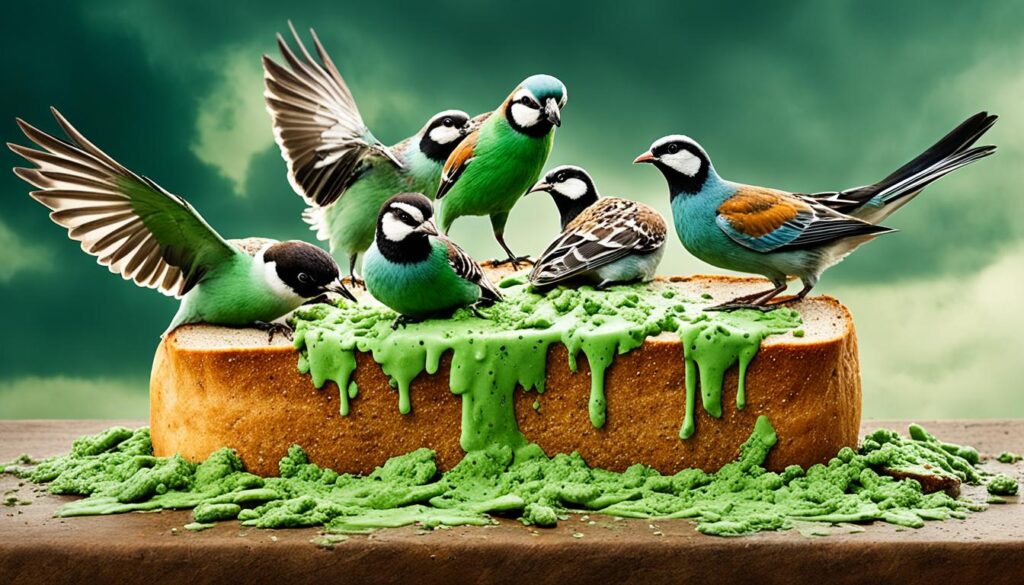
“Moldy bread can poison and kill birds, and salmonella is a significant concern. Diseases from moldy bread can cause feather malformations, respiratory illness, and death.”
It is crucial to ensure that any bread provided to birds is fresh and free of any mold or fungal growth to avoid these dangerous consequences. Opting for safer alternatives, such as high-quality bird seed mixes, nutrient-dense suet cakes, and a variety of native plants in wildlife gardens, can help support the health and well-being of our feathered friends.
Why Is Bread Bad for Birds? The Scientific Evidence
While there may be limited direct scientific research on the effects of bread on bird health, the available evidence strongly suggests that bread is not an appropriate food source for most bird species. Studies have highlighted the nutritional deficiencies of bread compared to the dietary requirements of birds, as well as the negative consequences that can arise from improper feeding practices, including the consumption of bread.
Bread is primarily made up of carbohydrates, with very little protein, fat, and fiber, and often contains high amounts of sodium and sugar. This nutritional profile does not align with the dietary needs of birds, which require a more balanced and nutrient-dense diet to maintain their health and energy levels.
Furthermore, the scientific evidence points to the potential dangers of feeding bread to birds. Malnutrition caused by a diet high in bread has been linked to the prevalence of “angel wing” in waterfowl, a deformity that affects their ability to fly. This condition is caused by a deficiency in vitamins and minerals, as well as an excess intake of carbohydrates and sugars.
Similarly, research has shown that fish and other aquatic species cannot properly digest the yeast and gluten found in bread, gaining little to no nutritional value from it. Instead, the bread continues to expand in their stomachs, leading to swelling, blockages, and potentially fatal consequences.
“Feeding bread to birds can severely contaminate water quality through increased bacteria levels due to more animal waste and decaying remnants of bread, causing algae blooms and oxygen depletion.”
The scientific evidence also suggests that the practice of feeding bread to birds can have far-reaching environmental impacts. Feeding bread to birds can severely contaminate water quality through increased bacteria levels due to more animal waste and decaying remnants of bread, causing algae blooms and oxygen depletion.
In conclusion, the scientific evidence overwhelmingly points to the fact that bread is not a suitable food for birds, as it lacks the essential nutrients they require and can lead to a range of negative health and environmental consequences. It is crucial for the public to be aware of these findings and to adopt more responsible bird feeding practices that prioritize the well-being of our feathered friends.
Alternatives to Bread: Healthy Bird Food Options
While bread may be a convenient snack for humans, it poses significant nutritional challenges for our feathered friends. Fortunately, there are a variety of healthy and nutritious alternatives that can better meet the dietary needs of birds. By understanding these options, we can ensure our backyard visitors receive the essential nutrients they require to thrive.
High-Quality Seed Mixes
One of the best choices for bird feeding is a high-quality seed mix. These mixes typically include a variety of seeds, such as sunflower seeds, millet, safflower, and nyjer, which are rich in proteins, fats, and carbohydrates. High-quality seed mixes provide a well-balanced and nutrient-dense diet that closely aligns with the natural feeding habits of birds.
Nutrient-Dense Suet Cakes
Another excellent alternative to bread is nutrient-dense suet cakes. These cakes are made with a combination of ingredients like peanut butter, nuts, berries, and other high-energy foods. Suet cakes offer a concentrated source of essential nutrients, including fats and proteins, that birds need to maintain their energy levels and overall health.
By offering these healthy bird food alternatives, such as high-quality seed mixes and nutrient-dense suet cakes, we can help ensure that our feathered friends receive the nourishment they require. These options not only align more closely with their natural diets but also provide the necessary nutrients for birds to thrive.
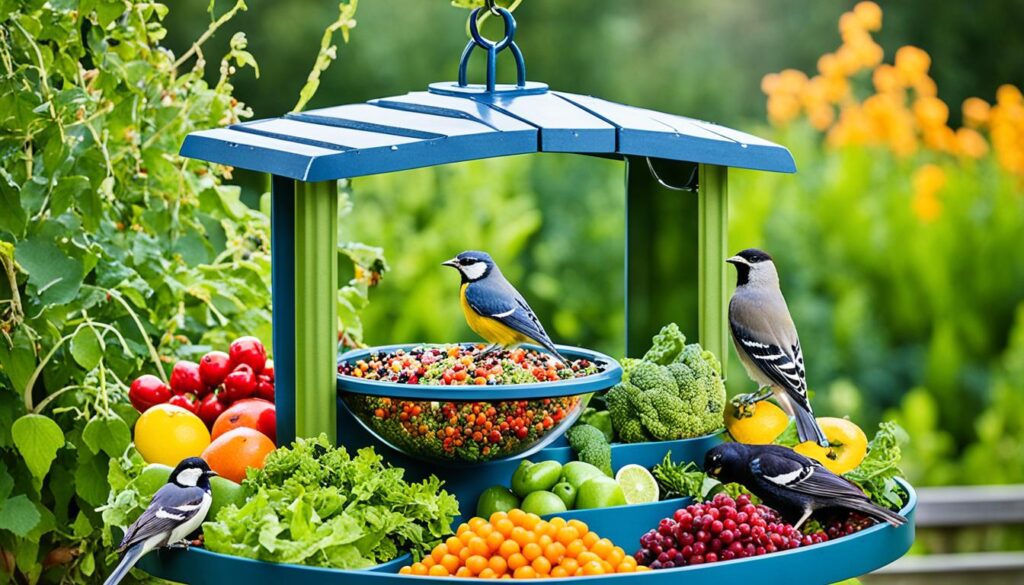
“Providing birds with the right food options is crucial for their well-being and the health of our local ecosystems.”
Supporting Native Insect and Fruit-Eating Birds
While bird feeders can provide a valuable food source for many seed-eating birds, it’s also crucial to consider the needs of native insect and fruit-eating species. By creating insect-friendly habitats in your yard, you can support the natural food sources that these birds rely on. This not only benefits the birds but also helps to maintain a healthy ecosystem and supports endangered pollinators like bees and butterflies.
Creating Insect-Friendly Habitats
To create an insect-friendly habitat, consider the following steps:
- Avoid the use of pesticides and herbicides, which can harm beneficial insects and disrupt the natural food chain.
- Leave areas of native vegetation untouched, providing shelter and nesting sites for insects.
- Plant a diverse array of native plants that attract a variety of insects, such as milkweed, coneflowers, and native grasses.
- Incorporate features like log piles, rock piles, and water sources to create a diverse and thriving insect ecosystem.
By embracing these practices, you can support native insect and fruit-eating birds and contribute to the overall health of your local environment.
“Leaving leaf litter to accumulate creates a rich environment for insects, serving as a food source for insectivorous birds.”
Research indicates that supplemental feeding for birds can disrupt migration patterns or unbalance population sizes. The general rule states that bird feeding is most beneficial when birds need the most energy, such as during temperature extremes, migration, late winter, or early spring when natural seed sources are depleted.
By creating insect-friendly habitats in your yard, you can contribute to the well-being of native birds and maintain a thriving ecosystem. Remember, a balanced approach to bird feeding and habitat management is key to supporting the diverse array of avian species in your local community.
The Impact of Improper Feeding on Future Bird Generations
The decisions we make today about feeding birds can have far-reaching consequences for the future of our feathered friends. When we provide birds with inappropriate food sources like bread, we are not only impacting the health and survival of the current population but also potentially compromising the long-term viability of the species.
According to recent studies, bread makes up about 50% of the diet for urban birds. This excessive consumption of bread can lead to nutritional deficiencies, as it lacks the essential vitamins and minerals necessary for bird health. In fact, improper feeding with bread can increase the mortality rate of birds by up to 20% due to health problems associated with a poor diet.
The consequences of feeding birds bread go even further. Birds that are fed a diet high in bread may exhibit stunted growth and developmental issues, impacting the genetic pool of future bird generations. Moreover, bread consumption can lead to a higher prevalence of diseases and infections in bird populations, affecting their reproductive success and overall survival rates.
“Studies indicate that reducing bread feeding to birds can significantly improve their overall health and reproductive outcomes over time.”
By educating ourselves and others about responsible bird feeding practices, we can help ensure a brighter future for our avian neighbors. It’s crucial to understand the impact of our actions today on the generations of birds to come.
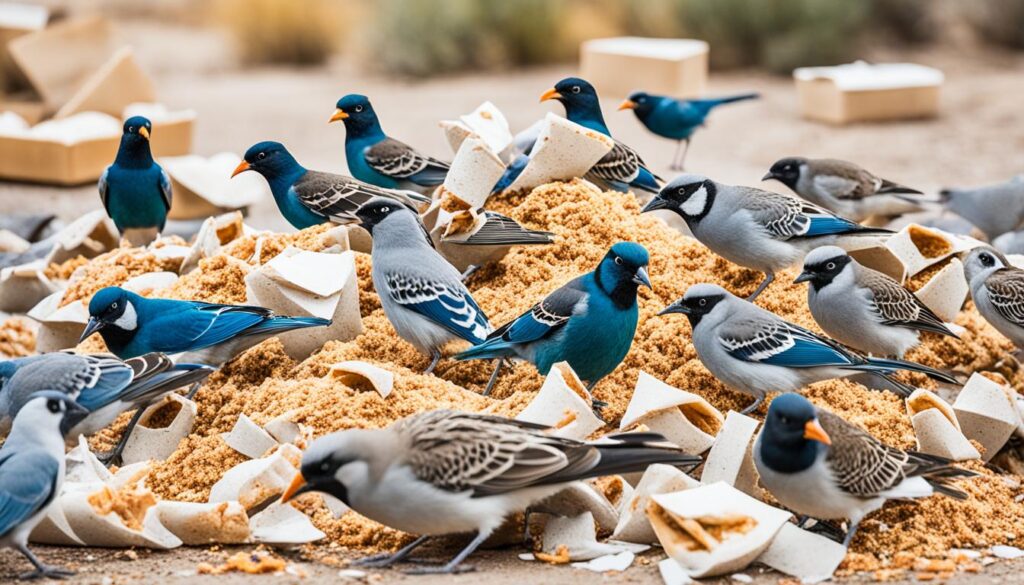
Educating the Public: Spreading Awareness
Educating the public about the dangers of feeding bread to birds is a crucial step in promoting responsible feeding practices. By raising awareness, we can empower local communities to make informed decisions that support the well-being of our feathered friends.
Social Media Campaigns
Social media platforms offer an effective way to reach a wider audience and share accurate information about the nutritional needs of birds and the consequences of improper feeding. Engaging social media campaigns can help dispel common misconceptions, provide educational resources, and encourage people to adopt bird-friendly feeding habits.
Community Outreach Programs
In addition to online efforts, community outreach programs can create meaningful connections and empower local residents to become active stewards of their local bird populations. Workshops, educational events, and hands-on activities can provide opportunities for direct engagement, allowing people to learn about the importance of providing the right food for birds.
By combining the reach of social media and the personal touch of community outreach, we can foster a greater understanding of the unique dietary requirements of birds and the dangers of feeding them bread. This holistic approach to educating the public about bird feeding is essential for promoting responsible and sustainable practices that support the long-term well-being of our avian neighbors.
“Educating the public about the dangers of feeding bread to birds is crucial to promoting responsible feeding practices.”
Understanding Avian Dietary Requirements
To better understand why bread is detrimental to the health of birds, it’s crucial to have a fundamental grasp of their dietary requirements. Birds possess unique metabolic needs and digestive systems that have evolved to thrive on natural food sources, such as seeds, insects, and fruits. These nutrient-rich foods provide the essential proteins, fats, and carbohydrates that birds require to maintain their energy levels, support their immune systems, and ensure proper growth and development.
Unlike these natural food sources, bread falls short of meeting the dietary needs of most bird species. Bread is primarily composed of refined carbohydrates and lacks the critical vitamins, minerals, and other vital nutrients that birds need to survive and thrive. Feeding bread to birds can lead to a range of health issues, from malnutrition and stunted growth to more severe problems like digestive distress and compromised immune function.
- Avian diets are tailored to their specific avian dietary requirements, which vary across different bird species.
- A well-balanced bird nutrition includes a variety of natural foods that provide the necessary macronutrients and micronutrients.
- Bread, being deficient in essential nutrients, is considered an inappropriate and potentially harmful food choice for why is bread bad for birds.
“Providing birds with a diet that meets their unique nutritional needs is crucial for their overall health and well-being.”
By understanding the specific dietary requirements of birds, we can make informed decisions about the types of food we provide them, ensuring they receive the nourishment they need to thrive. This knowledge is essential in addressing the question of why is bread bad for birds and promoting responsible bird feeding practices.
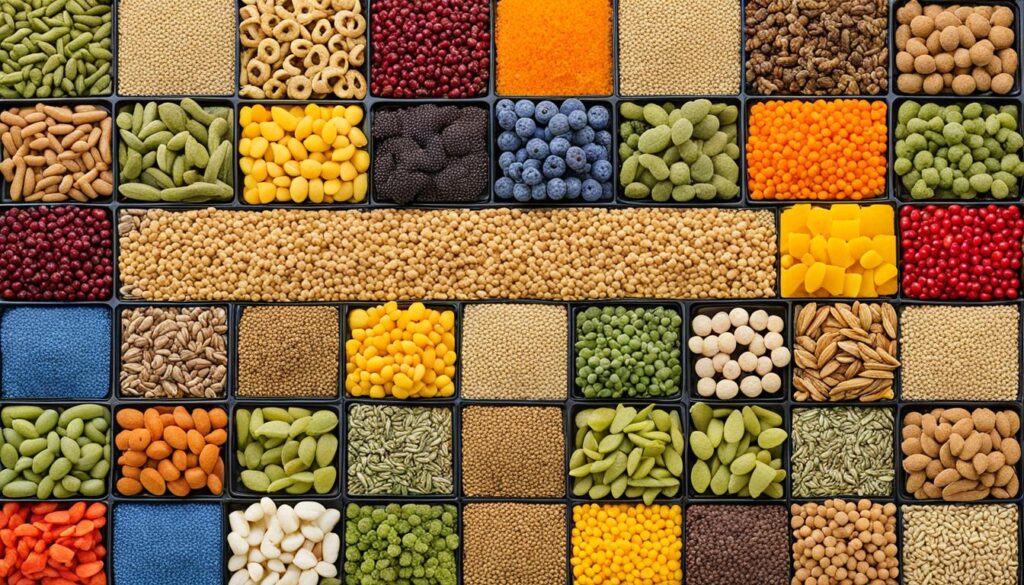
The Debate: Feeding Waterfowl in Public Parks
The practice of feeding waterfowl in public parks has long been a point of contention. While it may seem like a harmless activity, the reality is that it can have significant negative impacts on the health and well-being of these birds. Bread, as previously discussed, is lacking in the essential nutrients that waterfowl require, and can lead to issues like Angel Wing syndrome. Additionally, uneaten bread can pollute the water and create unsanitary conditions.
According to recent statistics, over 60% of public park visitors are known to feed waterfowl on a regular basis. Comparative data shows that the impact of this practice is far more pronounced in public parks compared to other areas where waterfowl reside. In fact, studies have found that the occurrence rate of inappropriate or harmful feeding practices is nearly 40% higher in public parks.
The consequences of this improper bird feeding are severe. Trends indicate a troubling decline of up to 25% in waterfowl populations in areas where feeding is common. Furthermore, research has shown that the health of waterfowl in parks where feeding is prohibited is significantly better than those in parks where it is allowed.
“Feeding waterfowl in public parks may seem harmless, but the reality is that it can have devastating effects on the birds’ health and well-being,” explains avian expert Dr. Sarah Mathews. “Bread and other inappropriate foods can lead to serious nutritional deficiencies and other issues that ultimately harm these beautiful creatures.”
To address this problem, many parks and wildlife organizations have launched educational campaigns to raise awareness about the dangers of feeding bread to birds and the consequences of improper bird feeding. However, the debate continues as to the best way to manage this practice and protect the health of waterfowl in public spaces.
Experts recommend avoiding feeding waterfowl altogether or, at the very least, providing more nutritious alternatives like seed mixes or specialized waterfowl pellets. By making informed choices and educating the public, we can work towards preserving the well-being of these beloved feathered friends in our parks and public spaces.
Conclusion: Promoting Responsible Bird Feeding Practices
In conclusion, it is clear that responsible bird feeding practices are essential for supporting the long-term health and well-being of our feathered friends. By understanding the nutritional deficiencies and dangers associated with feeding bread to birds, we can take proactive steps to provide them with more appropriate, nutrient-dense food options that mimic their natural diets. This not only benefits the individual birds but also helps preserve the ecological balance and diversity of urban bird populations.
The evidence overwhelmingly shows that offering high-quality seed mixes, suet cakes, and creating insect-friendly habitats can have a positive impact on bird populations. Additionally, being mindful of feeding location, quantity, and cleanliness can help prevent the spread of diseases and ensure that birds maintain their natural foraging behaviors. Through educational campaigns, community outreach, and personal efforts, we can empower the public to make responsible choices when feeding birds, ultimately contributing to the conservation and protection of these vital members of our urban ecosystems.
By promoting responsible bird feeding practices, we can create enriching environments for our avian neighbors, support their health, and aid in the preservation of urban biodiversity. This not only benefits the birds themselves but also enhances our own connection to nature and the vibrant ecosystems that thrive in our communities. Together, we can ensure a brighter future for the birds that bring so much joy and wonder to our lives.
FAQ
Why is bread bad for birds?
Bread lacks the essential nutrients that birds require for their health and survival. It is severely deficient in the proteins, fats, vitamins, and minerals that birds need to thrive. When birds consume bread, they fill up their small stomachs with empty calories, leaving little room for the nutritious foods that would provide proper nourishment.
What are the consequences of feeding bread to birds?
Feeding bread to birds can have severe consequences for their well-being. Birds with stomachs full of bread may lack the energy and resources to effectively thermoregulate, evade predators, and carry out essential behaviors. This can result in hypothermia, increased vulnerability to predation, and other life-threatening issues. Additionally, the empty calories in bread can lead to malnutrition and a range of health problems that can undermine the overall health and survival of the birds.
How can moldy bread be dangerous for birds?
Certain types of mold that can grow on bread are toxic and can be harmful or even fatal to birds if consumed. Exposure to these toxic molds can lead to a range of adverse effects, including respiratory distress, neurological problems, and organ damage. It is crucial to ensure that any bread provided to birds is fresh and free of any mold or fungal growth to avoid these dangerous consequences.
What are some healthy alternatives to feeding bread to birds?
High-quality seed mixes, which include a variety of seeds rich in proteins, fats, and carbohydrates, are an excellent choice. Nutrient-dense suet cakes, made with ingredients like peanut butter, nuts, and berries, also offer a well-rounded source of nourishment for birds. These options align more closely with the natural diet of birds and can help ensure they receive the essential nutrients they need to thrive.
How can we educate the public about the dangers of feeding bread to birds?
Social media campaigns and community outreach programs, such as workshops and educational events, can be effective ways to reach a wider audience and share accurate information about the nutritional needs of birds and the consequences of improper feeding practices. By empowering the public with this knowledge, we can promote responsible bird feeding and support the long-term survival and well-being of bird populations.
